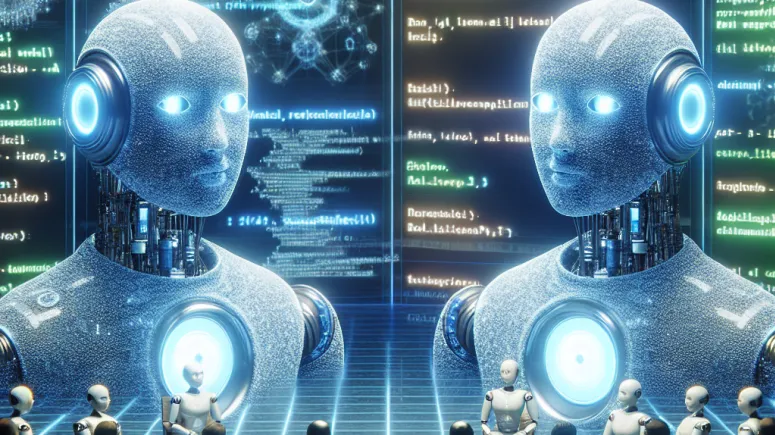AI chatbots have a serious side, and nowhere is that more clear to their aficionados than in the two big battalions currently fighting it out in 2024. These are the Minstrel troops of Google and the ChatGPT 4 forces of OpenAI. They present the very cutting edge of AI technology and the very pinnacle of personable AI chatbot programming. And while they’re not at war—yet—over the issue of which chatbot can deliver the most accurate information and most satisfying answers to client queries, the differences between them on the 21st-century “battlefield” are becoming clearer with each passing day.
Table of Contents
Unveiling the Battle of Intelligence: Google Bard vs ChatGPT 4
The modern world of technology is a place where the clash between Google Bard and ChatGPT 4 captures the unending interest of aficionados. When it comes to cutting-edge chatbots, these two are living up to the hype by offering an array of unmatched capabilities. They have skills that have set a new standard for the realm of conversational AI. As we head into the future of this space, the debate over which of these two dominant platforms should be the foundation for our next chatbot project is coming into sharper focus.
Key Differentiators google bard vs chatgpt 4
In the standoff between Google Troubadour and ChatGPT 4, the war zone is set, with each chatbot exhibiting its novel assets. Here are a few vital differentiators to consider:
- Access: Google Bard has real-time internet access through Google Search, setting it apart from ChatGPT 4, which retrieves the latest information swiftly.
- Code Generation: With its vast amount of carefully annotated coding data, ChatGPT 4 is highly proficient at code generation tasks. It has learned to follow coding conventions and can provide extremely detailed guidance for specific use cases.
- Trained Responses: Even though both chatbots are always getting better, Bard is especially good at giving short and direct answers. ChatGPT 4 consistently responds with more roundabout and detailed responses.
Enhancing the user experience
Innovation enthusiasts and both established and emerging organizations are delving into the intricacies of AI chatbots to understand the nuances between Google Minstrel and ChatGPT 4. These chatbots—which are increasingly served by artificial intelligence—aim to provide users with even more accurate and relevant solutions in their problem-solving across a range of fields.
Diving into Dataset Differences
Parsing the nuances of data sets is critical when assessing the disparities between Google’s Meena and OpenAI’s ChatGPT. Those disparities, after all, are what lend distinctive properties to these chatbots. And properties they do have: both are designed to be the best-in-class conversational bots, but they aim for different balances of speech accuracy and variety to achieve their superiority.
Data Comparison for google bard vs chatgpt 4
While taking apart the datasets used by Google Poet and ChatGPT 4, idiosyncrasies arise that influence their usefulness:
- Versatility: The Bard dataset improves its analysis and conversation capabilities. It pulls information from scientific papers, mathematical equations, and source code, giving it an expanded range of skills.
- Specialization: ChatGPT 4 instead uses a predetermined dataset. It may be very thorough, but it is lacking the most current and up-to-date information and the kind of coding-specific resources you’d find in the Bard dataset.
- Adaptability: Bard has real-time internet access that lets it give fast, current responses. In some situations where time is of the essence, ChatGPT4 vastly outperforms ChatGPT4 in providing accurate, swift replies.
Diving Deeper
As we explore the differences in datasets between Google Minstrel and ChatGPT 4, the reason for this divergence becomes clear. The datasets that underlie these chatbot creations directly affect their reflexes and their ability to tailor responses to the input they receive. Minstrel’s training seems to have imparted a narrower and more concrete sense of what it means to converse. In contrast, the foundation on which ChatGPT 4 is built spans an enormous range of past conversations, seemingly leaving more room for interpretation and, some might argue, creativity.
Evolutionary Trajectory
The chatbots change course completely, very much as existing datasets do. Yet, these chatbots also use the data they have in a way that makes their responses feel personal and tailor-made. If what they say is the same, why does it feel different when we read a ChatGPT 4 story and a Google Poet-generated story? It happens because ChatGPT 4 has a little more information than Google Poet. It is probably the combination of more and better data, more training, and a more sophisticated skill model that makes ChatGPT 4 stories feel less jumbled, even when they, too, ultimately lack human meaning.
Analyzing the Chatbot Showdown
Stepping into the chatbot world, we witness an epic battle between the two giants: Google with its Bard and OpenAI with its ChatGPT 4. These two AI powerhouses stand toe to toe in a contest of capability. The experience that will emerge from the intermixing of—what we may call—the three pillars (each stuffed with unresolved issues) provides an occasion to guess yet again at what might happen when these chunks of programmed lines meet the kind of purposeful dancing that amounts to effective conversation.
Functionality Frenzy
The conflict among Poet and ChatGPT 4 reveals a range of functionalities that set up for their standoff:
- Access Dynamics: Bard’s genuine internet connection improves its ability to respond swiftly and question honestly, making its information as current as possible.
- Response Aptitude: With its expansive amount of training data, ChatGPT 4 displays its prodigious talents in producing comprehensive, knowledgeable replies that cover an amazing range of subjects. It truly shines when it is asked to deal with intricate, hard-to-penetrate problems.
- Training Tactics: The way a chatbot is trained affects the quality of its responses. Training can steer a chatbot toward giving direct, to-the-point answers (like Bard) or can nudge its responses to be more expansive and detailed (like ChatGPT in earlier models).
Usability Insights
As I delve deeper into this chatbot brouhaha, I’m reminded of how fantastic it is that these tools of our digital age are popular and being used in many different ways. Even though they both got their start from the same OpenAI lab coat, the open-source product ChatGPT has a brother now: ChatGPT 4.0 Beta, in fact, with a new backbone. And now, with a fresh new brand name: ‘Codex.’ Reborn this way, ChatGPT is ruled by a few in a hierarchical way, similar to Transformer’s boilerplate code, which comes from the ‘obeyance’ condition to its unique’mastery’ state.
Future Prospects
Investigating what will happen to these powerful computer-based intelligence agents reveals a tapestry of conceivable outcomes and advancements. The ongoing progress of Google’s ChatGPT and ChatGPT4 promises a future in which interactions with chatbots are more reliable, varied, and tailored to the specific needs of individual users. This will usher in an unprecedented era of innovation in artificial intelligence.
Decoding 2024: Which Reigns Supreme?
As we travel the techno-scape of 2024, one question dominates: Who must stand supreme in Eliza Doolittle’s Pygmalion-esque evolution of artificial intelligence (AI)? Google’s Bard? OpenAI’s ChatGPT 4? They are two of the latest in a series of language models trained to understand and generate human text. And they are locked in fierce competition. Whichever one prevails is destined to make a major impact, both in how we use AI and in how researchers understand it.
Comparative Analysis
Setting out on an excursion of correlation between Google Troubadour and ChatGPT 4 uncovers vital bits of knowledge into their presentation:
- Functionality: Bard’s real-time access to the internet enhances its ability to provide the latest information promptly, whereas ChatGPT 4’s expansive dataset enables it to generate detailed responses across a wide range of topics.
- Adaptability: Bard’s specialization in concise answers contrasts with ChatGPT 4’s knack for elaborate and informative replies, catering to different user preferences based on response style.
Future Projections
The latest cutting-edge advances in artificial intelligence are found within the virtual verbal world of chatbots and virtual assistants. Two projects in particular—Google Poet and ChatGPT 4—hold the most promise for future day-to-day communications. The consistent fine-tuning of these two projects suggests a future where chatbot interfaces rival the voice actions we take on our smartphones and where virtual assistants could almost take up human-like conversation. Are we, however, heading in the proper direction? Will virtual help surpass the ‘I’m sorry, I don’t know the answer’ phase?
The Ultimate Showdown
As we attempt to unravel the delicate components of the technology field in 2024, two chatbots—Google Versifier and ChatGPT 4—stand at the forefront, serving as an illustration of the burgeoning artificial intelligence (AI) landscape. Although both wade in the waters of AI, the pair offer unique and worthwhile aspects. Yet, the living agents of resolution appear to be those who can adapt best to their clients’ demands and who can venture a little bit further into these new, uncharted AI waters as they persist in overcoming the reeling-in horrors enabled by the oceanic divinity of AI technology.
Cracking the Code: Access and Responses
Unraveling the technological intricacies, we come closer to understanding the mysteries of access and response during the competition between Google’s Bard and ChatGPT 4. Our focus narrows to a few basic questions: Can Bard get the data it needs? Can it understand it? Can it write new information that is beyond poor imitations of human reasoning?
Access Insights
With regards to abilities, Google Versifier and ChatGPT 4 each offer extraordinary qualities that would be useful.
- Real-Time Access: With Google Search and our real-time internet access, Bard can provide the latest information very quickly. Its responsiveness is because of this direct access.
- Dataset Use: ChatGPT 4 leverages its expansive dataset to offer detailed responses on a wide array of topics, showcasing its versatility in handling diverse user queries.
Unveiling Response Dynamics
Dissecting the elements of reactions is pivotal in understanding how Google Troubadour and ChatGPT 4 explore the domain of client communications.
- Response Precision: Bard’s inclination towards concise and direct responses contrasts with ChatGPT 4’s ability to provide elaborate and informative answers, catering to different user preferences.
- Training Influence: The training regimen of each chatbot plays a pivotal role in shaping the accuracy and depth of their responses, guiding their evolution in addressing user queries effectively.
The Path Forward
Exploring the fine points of access and response in the tech world, we find that Google Minstrel and ChatGPT 4 are among the most advanced systems. Their development continues to shape the artificial intelligence landscape, blazing a trail toward better and smarter interactions with users. The digital domain keeps on progressing, but these new chatbots are already at the bleeding edge, where the virtual and real worlds start blending together in a captivating way.







1 thought on “Google Bard vs ChatGPT 4: 2024 Chatbot Comparison”
Comments are closed.